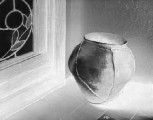Some technical information about the photographs
(this is from way back in the darkroom days)

Cameras: Wisner 4x5 Traditional wood field camera, Bronica ETRSi for portraits.
Film: Kodak T-Max 400 (TMY) at present; T-Max 100 (TMX) has also been used.
Developed in Gordon Hutchings' PMK pyrogallol formula, with Amidol added, in open trays.
Paper: Agfa Multicontrast Classic fiber-based paper. Prints are made in split-contrast fashion using separate yellow and magenta exposures. Typical developing sequence:
- developer, Ansco 120 metol-only formula with sodium replaced by the molar equivalent of potassium, at 1:3 for 3 minutes;
- acid stop bath;
- Kodak rapid fixer without the hardener;
- rinse;
- wash aid, sodium sulfite + sodium bisulfite solution, for three minutes, one-shot;
- wash, 20 minutes in a flat tray, 40 minutes in an upright washer.
Toning is usually performed with variations of the Ansco 221 ferricyanide bleach-sodium sulfide toner formula. Partial toning is performed using dilute bleach solutions; warmer tones are obtained by replacing potassium bromide with the molar equivalent of potassium iodide. The only other toners sometimes used are Kodak Rapid Selenium Toner and the blue gold toner formula. If Ansco 221 is not used, the prints are treated with a 0.1g per liter (1% of working) sodium sulfide solution for archival permanence.
Concerning permanence: the former practice of using selenium toner to ensure permanence has been called into question, evidently due to an inadvertent change in the KRST formula. According to Reilly et al., Stability of Black-and-White Photographic Images, with Special Reference to Microfilm, it was sulfide, not the selenium, that was responsible for the archival properties of the old KRST preparation. This is true of gold toners as well. Selenium and gold themselves do provide archival permanence, but only to the extent that the image silver is converted; partial toning does not fully protect the image. In contrast, mere exposure to a sulfiding agent appears to confer maximum protection. Per the article: “. . . sodium sulfide solutions of 0.1 grams per liter (about 1/100th of a percent) are completely effective. . . . processed microfilm of any age can be immersed in the [Kodak Brown Toner] solution for a few seconds (shorter immersion times require slightly higher concentrations than longer times), then washed and dried.” As I prefer a method which does not cause uncontrolled color change, any print that is not sepia toned, or toned to completion in selenium or gold, is treated in a sodium sulfide solution for permanence. As the above research was done with very thin-emulsion microfilm, I use a one-minute treatment time for prints.
Prints are mounted and matted with Crescent museum rag board using Seal Archival Mount tissue. I recommend using either Crescent acid-free foamcore or Bainbridge Artcare archival foamboard behind the print, and acrylic (Plexiglas) in the frame.
Color images are taken with Kodak 120 Professional Portra 160 Color Negative Film, then professionally developed, scanned and printed with an inkjet printer.